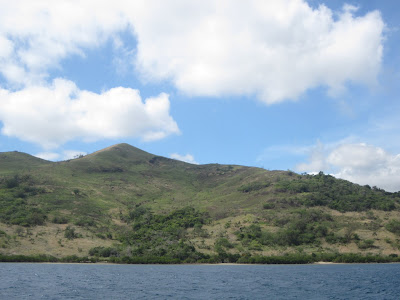By the time the weather broke, it was time to get the boat
to the west side of Viti Levu ,
Fiji
The camera kept clicking, though! Some sights from our "motel anchorages":
 |
| Since it's near the end of the safe cruising season, we had the immense and tranquil Mbua Bay all to ourselves |
we were able to visit.
In Fiji ,
islands and their surrounding reefs and waters are owned by the people (not
the king, as in Tonga ).
Custom dictates that guests bring an offering of yaqona (kava root) to the village chief, who gives his permission
for visitors to stay, swim, hike, take photos, etc. The asking and receiving of
permission is highly ritualized, and can involve making and drinking kava in an
elaborate ceremony. We didn't get the ceremony, but village headman Ben helped us
complete the formalities with Chief Johnny (who later visited our boat for a
cold drink).
It turned out to be the most delightful village experience we've had anywhere, with enthusiastic 'Bula!'s (Hellos) greeting us from all the homes. People were eager to introduce themselves and find out about us: name, age, origin (word spread fast that we were from '
 |
| All homes were close to this narrow cement sidewalk, had laundry hanging outside and large woven mats covering the floors inside. Even the traditional thatched bures had solar panels! |
 |
| Closeup of a bure |
 |
| Boy on the beach |
 |
| Kids in the new part of the village-- corrugated metal homes that replaced bures destroyed by a hurricane |
 |
| Me: "You have such beautiful eyes!" Her: "I like your tattoo." Me: "It's a picture of Harmony; it means we are all connected to each other." Her: a great big smile... |
The west anchorage was a
magical place:
beaches, snorkeling reefs,
sunset views.
Ah, to have been able to stay
for a few days!
But even one was a gift...
This is not an anchorage, but it's not just ocean, either. It's betweenFiji 's
two main islands and is called Bligh Water--named after the captain of the Bounty. In 1789, he and his loyal crew
of 18 men, after being dumped by mutineers in Tonga , rowed for their lives across
this water to escape cannibals. Not only did they avoid a gruesome fate,
Bligh completed one of the most remarkable feats of navigation in maritime
history, guiding the small open boat over 3600 miles to a safe landfall in Indonesia .
magical place:
beaches, snorkeling reefs,
sunset views.
Ah, to have been able to stay
for a few days!
But even one was a gift...
This is not an anchorage, but it's not just ocean, either. It's between
These aren't anchorages either, but sights along the north coast of Viti Levu:
 |
| This area looked much drier than we expected. To our surprise and delight, the contours and the vegetation actually looked very much like the hills around Ashland. |
 |
| Reefs like this are often invisible at higher tides |

























